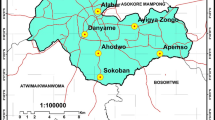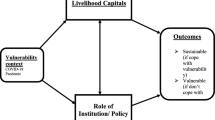Abstract
Migration-driven population growth coupled with limited formal job supply in Bichena escalates unemployment and the numbers of informal business operators. The purpose of this study was to investigate the deriving factors and socioeconomic status of women informal business operators in Bichena town, west-central Ethiopia. Mixed research approaches were used to acquire and analyze data. Purposive and convenient sampling techniques were employed to select sample kebeles and 245 respondents, respectively. The study employed questionnaires, interviews, field observations, and document review to collect data. The data were analyzed quantitatively using SPSS and qualitatively. The study revealed lack of options for survival; divorce and/or widow; limited household income; easy entry requirements (education and finance); and flexibility of the business as prominent factors for women's engagement in the informal sector. The study also indicated that women informal workers largely operate small survival-based business with low profits. Consequently, more than half of the respondents obtained very low monthly income (≤ 29.5 USD) with no saving habit, and about one-third of them failed to cover their monthly expenses. The statistical analysis demonstrated that age, family size, type of informal business, and work experiences had a significant influence on respondents' monthly income. The income, expenditure, and saving conditions of respondents vary across the types of informal activities. The study further revealed that women informal workers in Bichena have low livelihood assets ownership except for social capital. The informal sector generally serves as a survival strategy for migrant and urban poor women; thus, the town administration should work hand-in-hand with other stakeholders to empower informal workers through designing appropriate policies/strategies.


Source: field survey

Source: field survey

Source: field survey

Source: field survey

Source: field survey
Similar content being viewed by others
Availability of data and material
The datasets used and/or analyzed in this study are found in the hands of the corresponding author.
Notes
Ethiopian traditional fermented alcoholic drink made from grains, the leaves of gesho (buckthorn) and malt.
A colorless distilled traditional alcoholic beverage prepared in Ethiopia from the same ingredients as tella.
An administration unit holding kebeles in Ethiopian context.
Smallest administrative units in Ethiopia.
ETB denotes the Ethiopian Birr (currency), 1 USD ≈ 34 ETB during the study period.
References
AfDB, UNDP (2012) African economic outlook 2012: promoting youth employment. OECD Publishing. Accessed Jan 2018
Afework A (2011) Urban informal sector as a livelihood strategy of women: the case of ‘Tella’ and ‘Katicala’ Producers and Sellers in Dejen Town, East Gojjam Zone. Addis Ababa University, Amhara Regional State
Alemu YT (2012) Challenges and Prospects of Women in the informal sector business in Addis Ababa: the Case of Merkato. MA thesis, aau
Becker KF (2004) The informal economy: fact finding study. Sida, Stockholm
Belay G (2012) Determinants of microenterprise success in the urban informal sector of Addis Ababa: multidimensional Analysis. Erasmus University Rotterd, Netherlands
Bewick V, Cheek L, Ball J (2004) Statistics review 9: one-way analysis of variance. Crit Care 8(2):130
Bodo T (2019) Rapid urbanisation: theories, causes, consequences and coping strategies. Ann Geogr Stud 2(3):32–45
Bonnet F, Vanek J, Chen M (2019) Women and men in the informal economy: a statistical brief. International Labour Office, Geneva. http://www.wiego.org/sites/default/files/publications/files/Women%20and%20Men%20in%20the%20Informal,20.
Castells M, Portes A (1989) World underneath: the origins, dynamics, and effects of the informal economy. In: The informal economy: studies in advanced and less developed countries, vol 12
Central Statistical Agency (CSA) (1994) Population and housing census of the Federal Government of Ethiopia. Addis Ababa, CSA
Central Statistical Agency (CSA) (2000) Statistical report on the 1999 national labor force survey. Addis Ababa, CSA
Central Statistical Agency (CSA) (2003) Report on urban informal sector sample survey. Addis Ababa, CSA
Central Statistical Agency (CSA) (2007) The 2007 population and housing census of Ethiopia. Addis Ababa, CSA
Central Statistical Agency (CSA) (2011) Report on the 2011 national labor force survey. Addis Ababa, CSA
Chen MA (2001) Women and informality: a global picture, the global movement. SAIS Rev 21(1):71–82
Chen MA (2005) Rethinking the informal economy: linkages with the formal economy and the formal regulatory environment. WIDER research paper
Chen MA (2012) The informal economy: definitions, theories and policies. WIEGO working paper
Chen MA, Vanek J, Carr M (2004) Mainstreaming informal employment and gender in poverty reduction: A handbook for policy-makers and other stakeholders. Commonwealth secretariat
Chen M, Vanek J, Heintz J (2006) Informality, gender and poverty: a global picture. Economic and political weekly, 2131–2139
Cherinet H, Mulugeta E (2003) A profile on gender relations: towards gender equality in Ethiopia. Swedish International Development Cooperation Agency, Stockholm
Cochran WG (1977) Sampling techniques, 3d edn. Wiley
Creswell JW (2014) A concise introduction to mixed methods research. Sage Publications
Creswell JW, Clark VLP (2017) Designing and conducting mixed methods research. Sage Publications
Das S, Kotikula A (2019) Gender-based employment segregation: understanding causes and policy interventions. World Bank
Dea M (2016) The prospectus, challenges and causes of gender disparity and its implication for Ethiopia’s development: qualitative inquiry. J Educ Pract 7(4):24–37
Deribie E (2012) Women in the informal sector: evidence from southwestern Ethiopia. Int J Peace Dev Stud 3(6):112–117
Desta CG (2018) The urban informal economy in Ethiopia: Theory and empirical evidence. East Afr Soc Sci Res Rev 34(1):37–64
Desta M, Haddis G, Ataklt S (2006) Female-headed households and livelihood intervention in four selected weredas in Tigray, Ethiopia. Drylands Coordination Group, Miljøhuset G, 9
Elder S, Smith A (2010) Women in labour markets: measuring progress and identifying challenges. International Labour Office, Ginebra, Suiza
Elgin C, Oyvat C (2013) Lurking in the cities: urbanization and the informal economy. Struct Chang Econ Dyn 27:36–47
Fayomi OO, Adebayo TG, Okorie UE (2017) The resilient and informal economy and African development
Fields GS (2012) Challenges and policy lessons for the growth-employment-poverty nexus in developing countries. IZA J Labor Policy 1(1):1–24
Floro M, Meurs M (2009) Global trends in women’s access to “Decent Work” International Labour Organization. Geneva Office
Gundogan N, Bicerli MK (2009) Urbanization and labor market informality in developing countries
Haregewoin C, Emebet M (2002) Gender Profile of Ethiopia. SIDA.
Hart K (1973) Informal income opportunities and urban employment in Ghana. J Mod Afr Stud 11(1):61–89
Hussmanns R, Mehran F (1999) Statistical definition of the informal sector-International standards and national practices. Paper presented at the the 52nd session of the International Statistical Institute.
ILO (2002) Women and men in the informal economy: a statistical picture. ILO, Geneva
ILO (2016) Women at work: trends 2016. ILO, Geneva
ILO (2017) World employment and social outlook: trends for women 2017. ILO, Geneva
Jenberu AA, Admasu TG (2019) Urbanization and land use pattern in Arba Minch town, Ethiopia: driving forces and challenges. GeoJournal 85:1–18
Kassa AF (2012) Unemployment in urban Ethiopia: Determinants and Impact on household welfare. Ethiop J Econ 21(2):127–157
Ministry of Finance and Economic Development (MoFED) (2012) Ethiopia’s progress towards eradicating poverty: an interim report on poverty analysis study (2010/11). MoFED, Addis Ababa
Moore DS, Notz WI, Fligner MA (2015) The basic practice of statistics. Macmillan Higher Education
Moser CO (1978) Informal sector or petty commodity production: dualism or dependence in urban development? World Dev 6(9–10):1041–1064
Ntseane PG (2019) The informal economy in developing societies: implications for the learning cities concept. In: Learning cities, town planning, and the creation of livelihoods, IGI Global, pp 94–107
OECD (2015) The metropolitan century: Understanding urbanisation and its consequences. OECD Publishing
Ortiz-Ospina E, Tzvetkova S, Roser M (2018) Women’s employment. In Our world in data
Otobe N (2014) Resource guide on gender issues in employment and labour market policies: working towards women’s economic empowerment and gender equality. ILO, Geneva
Pallant J (2011) SPSS survival manual 4th edition: a step by step guide to data analysis using SPSS version 18. Open University Press, Maidenhead, Berkshire
Park HM (2009) Comparing group means: t-tests and one-way ANOVA using Stata, SAS, R, and SPSS
Perry GE, Arias O, Fajnzylber P, Maloney WF, Mason A, Saavedra-Chanduvi J (2007) Informality: exit and exclusion. World Bank
Phan D, Coxhead I (2010) Inter-provincial migration and inequality during Vietnam’s transition. J Dev Econ 91(1):100–112
Reichlin L, Shaw E (2015) Gender, urbanisation and democratic governance: white paper written for the Institute for Women’s Policy Research
Seleshi S (2012) The Role of Informal Sector in Food Security: the Case of Addis Ababa. MA thesis, aau
Sethuraman S (1981) The urban Informal sector in developing countries: employment. Poverty and environment. ILO, world employment program
Shehu E, Nilsson B (2014) Informal employment among youth: evidence from 20 school-to-work transition surveys. ILO, Geneva
Sibhat EE (2014) Cause and effect of informal sector: the case of street vendors in Addis Ababa. Addis Ababa University
Tejani S, Milberg W (2016) Global defeminization? Industrial upgrading and manufacturing employment in developing countries. Fem Econ 22(2):24–54
Todaro MP (1997) Urbanization, unemployment and migration in Africa: theory and policy
Tokman VE (1979) An exploration into the nature of informal—formal sector relationships. In: The urban informal sector. Elsevier, pp 1065–1075
UNFPA (2007) State of world population 2007: unleashing the potential of urban growth. United Nations
UN-Habitat (2016) Urbanization and development: emerging futures; world cities report 2016. UN Habitat: Nairobi
UN (2019) World population prospects 2019: highlights. In: New York (US): United Nations Department for Economic and Social Affairs. Population Fund
USAID, MOH, UNFPA, and EHNRI (2012) Ethiopia demographic and health survey 2011. Central Statistical Agency Addis Ababa, ICF International Calverton, Maryland, USA
Vanek J, Chen M, Hussmanns R, Heintz J, Carré F (2012) Women and men in the informal economy: a statistical picture. ILO and WIEGO, Geneva
Vanek J, Chen MA, Carré F, Heintz J, Hussmanns R (2014) Statistics on the informal economy: Definitions, regional estimates and challenges. In: Women informal employ glob organ work pap 2
Vijayvargiya A (2009) One-way analysis of variance. J Valid Technol 15(1):62–64
Wamuthenya W (2009) Gender differences in the determinants of formal and informal sector employment in the urban areas of Kenya across time. https://editorialexpress.com/cgibin/conference/download.cgi?db_name=IAFFE2009&paper_id
Woldie SH (2015) Women in the informal sector: retrospect’s and socioeconomic response in Dessie town, Ethiopia: the case of parallel trading. Int J Dev Soc 4(2):85–94
Acknowledgements
All participants during the household survey and key-informant interview are highly acknowledged for their time and willingness. The authors also would like to thank Bichena town administration, Small and Micro-Enterprise office, and Women, Children and Youth Affairs of the town for providing data during the fieldwork.
Funding
The authors received no funds for this research.
Author information
Authors and Affiliations
Corresponding author
Ethics declarations
Conflict of interest
The authors declare that they have no conflict of interest.
Consent to participant
The authors collected the data from the study area with the approval of concerned stakeholders and participants' full consent.
Additional information
Publisher's Note
Springer Nature remains neutral with regard to jurisdictional claims in published maps and institutional affiliations.
Rights and permissions
About this article
Cite this article
Jenberu, A.A., Kasse, G.M. Deriving forces and socioeconomic status of women in the urban informal sector in Bichena Town, West-Central Ethiopia. J. Soc. Econ. Dev. 23, 258–282 (2021). https://doi.org/10.1007/s40847-021-00157-x
Accepted:
Published:
Issue Date:
DOI: https://doi.org/10.1007/s40847-021-00157-x




